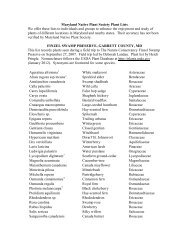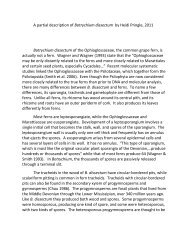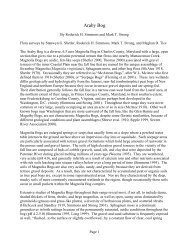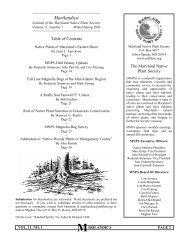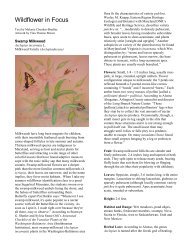Swamp Milkweed - Maryland Native Plant Society
Swamp Milkweed - Maryland Native Plant Society
Swamp Milkweed - Maryland Native Plant Society
Create successful ePaper yourself
Turn your PDF publications into a flip-book with our unique Google optimized e-Paper software.
ow that winter has arrived it's a<br />
great time to evaluate our home<br />
gardens and landscaping to see<br />
how wildlife fit into the plan. By<br />
providing nutritious food, clean water, and<br />
protection from predators and the cold,<br />
gardeners can make a big difference for our<br />
wildlife friends, especially during the winter.<br />
Here are some tips that we use on our<br />
property that and can be used in your gardens<br />
too. Your location and species might be different<br />
but the same basic principles will apply.<br />
Do your research.<br />
One of the best ways to provide essential<br />
habitat elements in your garden is to use plant<br />
material that is native to your region and in<br />
most cases indigenous to your own micro<br />
climate and soil conditions. See what plants<br />
are native to your area and what kinds of<br />
plant-animal relationships you have.<br />
Most often when we think of feeding wildlife<br />
in the winter it relates to birds. Providing bird<br />
food is a great way to attract and help our<br />
feathered friends. <strong>Native</strong> plants produce<br />
berries, nuts and seeds that birds relish. ink<br />
of bird feeders as providing a supplemental<br />
food source for birds when natural food is<br />
scarce.<br />
If you do decide to use a bird feeder be sure to<br />
keep it clean. Small mammals might be<br />
attracted to these feeders and in turn feed<br />
some of our predators like foxes and raptors.<br />
If you live in the city and don't want to attract<br />
rodents, use only seed that will not be wasted<br />
Marilandica Fall 2010<br />
Winterizing Your Garden for Our Wildlife Friends<br />
Carole Bergmann<br />
or tossed out by a finicky visitor. e best<br />
combinations are hulled sunflower seeds,<br />
thistle and suet. is will attract and sustain<br />
the largest variety of bird species.<br />
Here in suburban <strong>Maryland</strong> we have provided<br />
native tree and shrub species such as winterberry<br />
holly, viburnums, dogwoods, and sugar<br />
maple to help support our winter birds. It's<br />
important to remember to not cut back native<br />
perennials with seeds in the fall.<br />
We leave all of the plants standing such as<br />
coneflowers, sunflowers, blazing star, and<br />
black-eyed susans and watch the small birds<br />
like finches snack on them through the cold<br />
and snow. ese plants provide native wildlife<br />
food, garden interest and overwintering<br />
shelter for many insects, eggs and larva.<br />
Remove any non-native, invasive species that<br />
birds may carry with them to deposit in<br />
sensitive natural areas.<br />
Winter shelter is extremely important to our<br />
critter friends. Loss of habitat is the biggest<br />
threat to many wildlife species today. By<br />
doing our part to provide shelter from predators<br />
and winter weather we increase the<br />
chances for their survival. <strong>Plant</strong>ing native<br />
evergreen trees like spruce, cedar, hemlocks<br />
and firs will provide essential shelter for many<br />
songbirds and small mammals.<br />
If you have a deciduous wooded lot with dead<br />
trees standing, please consider leaving them<br />
standing if there is no risk of injury if they<br />
fall. ese provide important habitat for our<br />
cavity dwellers. Birdhouses can serve as winter<br />
roosting boxes. Prepare the birdhouse by<br />
cleaning it and stuffing it with a lining of dry<br />
grasses or shredded newspapers.<br />
Another great way to provide shelter is to<br />
construct a brush pile. roughout the year<br />
we gather mounds of yard debris including<br />
twigs and branches. is plant material can be<br />
recycled into a wonderfully diverse minihabitat<br />
of its own. ink of the brush pile<br />
having multiple layers for different species.<br />
On the bottom layer you would have logs or<br />
large branches. As the pile grows, build it up<br />
left: e Baltimore Checkerspot, <strong>Maryland</strong>’s state butterfly (endangered), eating and laying eggs on its larval host plant, the Turtlehead, Chelone glabra.<br />
Middle: Emerging monarch butterfly. right: Night flying hawkmoth in the photographer’s garden.<br />
Jim Gallion<br />
Carole Bergmann<br />
with yard waste like leaves, small branches<br />
and twigs. e size of your brush pile can vary<br />
depending on the space and location you have<br />
available. ese brush piles invite small mammals,<br />
salamanders, insects and birds. For best<br />
results do not disturb the site except to gently<br />
add new material in the fall.<br />
Flowing water is an important element for<br />
winter survival. Most of us don't have a<br />
natural spring or creek in our yards. In the<br />
winter birds are looking for water to bathe in<br />
and to drink, and small mammals need water<br />
too. Water can be provided in something as<br />
casual as a heated dog dish all the way up to<br />
an elaborate pond with a flowing stream and<br />
waterfall. It's important to have water that's<br />
not frozen. Ponds with some debris and<br />
potted plants at the bottom provide overwintering<br />
places for frogs and other aquatic life.<br />
Winter is the time we step back and evaluate<br />
(continued on page 9)<br />
page 3




